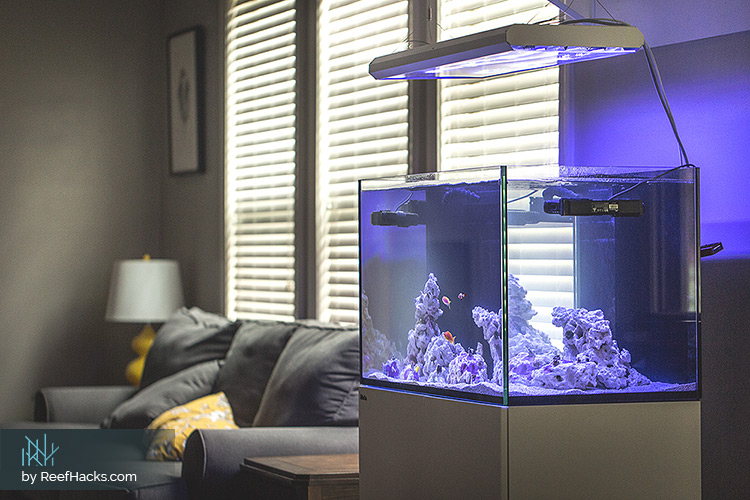Taking the plunge into the beautifully mysterious realm of reef aquariums can feel daunting. Trust me, even as a lifelong aquarium admirer and hobbyist, branching out into the salty world of reef tanks was a huge step.
While establishing and caring for a reef tank isn’t the easiest, the joy and splendor of this hobby is worth every ounce of effort.
It’s with a genuine sense of excitement, and respect, that the entire Reef Hacks team welcomes you into the watery world of saltwater and reef aquariums!

Author:
As a lifelong aquarist, Yuliya has an endless curiosity about our underwater universe. After graduating with a bachelor’s in Environmental Engineering, she transformed her passion into a successful career. While working at the Institute of Environmental Protection in Moscow, her passion for saltwater and reef aquariums only increased. Moving to the United States in 2013, Yuliya embarked on another impactful journey by sharing her unprecedented experience for all aquarium hobbyists ... Read More.
First things first, I want to briefly touch on why deciding to become a Reefer is an amazing opportunity to strengthen your aquarist skills. I can’t tell you how many aspiring aquarists I’ve known throughout my journey who fantasied about this hobby, but never fully committed.
It’s understandable. Unless you know a reefer, it’s easy to feel overwhelmed while reading blogs and advice columns. Thankfully, you aren’t alone. Along with our support, there’s a myriad of supportive online groups dedicated to this rewarding hobby.
Before moving forward, take some time to join and browse the following forums:
Obviously, there’s many more forums and online groups dedicated to our hobby, but the aforementioned forums are by far the most relevant. Browse through the threads and make friends. Both online communities are welcoming to novice and experienced Reefers.
Next, and perhaps the most difficult topic to clarify, is confirming you are, in fact, ready to dive into our salty world of exotic coral and mystical fish. As with any hobby, the reasons why you’re drawn to this field is solely unique.
However, by reading this article, you’ve already made the first step in becoming a true Reefer: the search for factual information. Like many of us, our journey into reef aquatics began with nothing more than a desire. While some, such as myself, already held a solid understanding of freshwater aquariums, many others have never owned a tank. But, this is the beautiful nature of our beloved hobby.
The only prerequisite is a desire to learn. Seriously, that’s it. As long as you’re ready to dedicate yourself to this rewarding hobby, it doesn’t matter if you’re well-versed in testing water parameters, or simply know you enjoy the beauty of coral. Reef aquatics is open and ready to embrace all who desire to learn.
Before delving into the specifics of finding and starting a reef tank, let me echo my earlier sentiments: welcome to the exciting world of reef tanks!
And now, let the fun begin!

Crunching the Numbers - Reef Tank Budget/Cost.
There’s no way around it, reef tanks aren’t the cheapest. Sure, there’s “low-end” tanks available, but why would you trust a discount item with the responsibility of safely holding gallons-upon-gallons of water?
For many aspiring aquarists, the notion of spending hundreds of dollars on a suitable tank is enough to thwart their plans. Yes, there are reef tanks that cost thousands, but you don’t need to refinance your mortgage to acquire a reliable (and attractive) tank.
It’s important to understand that your tank is an investment. Purchase a solid tank, and it will last you years. Purchase a discounted tank, and you may end up with your aquarium all over your living room floor. Let’s not tempt fate for the sake of saving a few dollars.
Here are key takeaways when budgeting for a reef tank:
The bulk of your investment comes at the very beginning. Therefore, it may cost a decent amount to get started from scratch, but you’ll rarely incur the same level of expense.
- Choose a solid tank with a good reputation among experienced Reefers, such as the Red Sea REEFER Series for example.
Other trusted brands:
- Innovative Marine
- ELOS
- Reef Savvy
- Be wary of sales gimmicks. If a tank sounds too good to be true, it probably is.
- When in doubt, send us a Facebook message or ask the reefing community at one of the forums mentioned earlier.
This is our favorite online store:
One Size Does NOT Fit All - Reef Tank Size & Capacity.
Many years ago, a dear friend of mine began her adventure into reef aquariums. While she was familiar with freshwater systems, which is how our friendship began, she knew very little about saltwater tanks.
In an attempt to streamline the entire process, she figured going with a small tank would be easier, cheaper and more efficient. So, what was the issue? Small reef tanks, oftentimes called Nano Tanks, may be compact, but its size comes at a price: precision or peril.
Essentially, nano reef tanks are notoriously difficult to keep as even the smallest issue can spell disaster for the entire ecosystem. Because of its compact size, if you aren’t able to swiftly make adjustments, the whole tank can crash.
While experienced aquarists understand the methodology of making quick adjustments, and preventing issues from occurring, such tactics are often cultivated through years of experience.
Take my advice: don’t jump into the nano reef tank quite yet.
I would recommend choosing a tank between 20 and 65 gallons including the sump volume. This is large enough to become aware of any issues before they overtake and crash the tank. It also fits well in most indoor spaces, such as in your living room or office.
Here are a few takeaways regarding reef tank size:
- Smaller isn’t better. Choose a tank that’s at least 20 gallons.
- Don’t choose a tank simply because you appreciate its design. Take a moment to investigate the construction and functions of a tank. A beautiful aquarium looses its luster when it leaks all over your floor.
- When in doubt, reach out to the community.
There Sumpthin’ About It - Reef Tank Sump System.
Now that we’ve touched on tank budget and capacity, it’s time to get to the meatier topics. The first on this list is the sump.
Essentially, the sump acts like a buffer system by increasing water volume and providing a streamlined area to store equipment. As with many elements of a reef tank, you have options, which are: All-in-One Systems and Tanks with Sump.
Let’s take a moment and explore the differences between these two designs.
All-in-One Systems, as its name suggests, feature filtration chambers attached to the back of the tank. This design offers a continuous flow of water through the back chambers. This is a nice option, and one we use for some tanks. The most noteworthy benefits of this design is its possibilities, such as begin able to place the entire tank system on your own stand. Like for example our Innovative Marine 20 NUVO Fusion tank.
However, it’s not without its drawbacks. Because the filtration chambers are located on the back of the tank, it doesn’t offer as much flexibility as reef tanks with a sump. Moreover, All-in-One Systems are best used for nano tanks, which as we discussed above, aren’t ideal for newcomers. But Innovative Marine offer a wide variety of sizes, so I'm sure you'll find an all in one reef tank over 20 gallon with no problems as well.
So, what about Sump Tank models? Overall, these aquariums offer a more streamlined experience that feels more intuitive.
This inclusive design simplifies equipment setup, but also satisfies a common concern: visual clutter. It’s no secret saltwater tanks require a myriad of pipes, additional tanks and other miscellaneous items. The brilliance of this type of aquarium is it allows immediate access to essential aquarium components while simultaneously hiding them from view.
Essential Takeaways:
- Sump-included reef tanks offer the most functional and aesthetic value.
- This type of tank is generally more interesting to run and offers streamlined access to essential components.
The Invisible Barrier - Glass or Acrylic Tanks?
Once you become more active in the reefing community, and begin investigating forums and other online groups, you’ll notice there’s quite a debate regarding the actual tank material.
For some, acrylic tanks are the “perfect” choice. For others, glass is hands-down the optimal option. I’m not here to solve this debate, but what I can do is offer my two-cents.
Personally, I prefer glass tank rather than its acrylic counterpart. As you’ll quickly discover, I’m not alone with this opinion. While glass aquariums are heavier than its acrylic counterpart, glass offers a host of advantages.
The most noteworthy include:
- Relatively, Scratch Resistant.
- Doesn’t Turn Yellow (a common problem with acrylic tanks).
- Non-Porus.
- Some acrylic tanks bow over time.
- Generally, Less Expensive.
Of course, when you move into comparing glass aquariums, there’s an entirely new world of options, While there’s obviously multiple minor details, the biggest element to consider is the iron content.
In case you didn’t already know, glass features an iron content. While this knowledge doesn’t often come into play, when deciding on a glass aquarium, it’s essential to understand why low-iron glass is always the best choice.
In brief, lower iron content means higher light transmission. This means greater light access to your reefs and other tank inhabitants, as well as a brilliantly clear view into this underwater world. Low iron aquariums are, by far, the most desired tank material among professional reefers.
Essential Takeaways:
- Glass reef tanks offer greater flexibility, durability and appearance than acrylic.
- Low-iron glass tanks transmit more light into the tank and offer a clearer view into the tank.
- Visit your local aquarium store to see the difference between glass and acrylic tanks.
Cultivating Your Slice of the Ocean - The Next Steps.
While there’s many other elements involved in selecting a reef tank, we’ve covered the foundational options. After reading through this piece, it’s safe to say a solid system is a glass tank with an included sump that’s at least 20 gallons.
At this point, I’m sure you’re wondering what tank we use for this guide? Our preferred tank system is no secret. We use the Red Sea REEFER series tanks and the REEFER 170 model for this guide as example. This is our personal favorite for many reasons, which we’ve written about in previous articles, but its cost and size is ideal for many newcomers. The price isn’t the lowest, but it also is far from the most expensive. We recommend this tank due to its reliability, ease and cost-effectiveness. Definitely check it out the full REEFER Series on Marine Depot.
So, what’s the next step?
Now that you’ve got a basic reef tank setup in mind, it’s time to think about the next level of reefing, lights! Just as the sun is a vital component for ocean life, aquarium lighting is equally as important.
Join us in our next guided adventure as we illuminate your understanding of tank lighting systems!
As always, if you have any questions or concerns, head over to our Facebook page and send us a message. On behalf of the entire Reef Hacks team, welcome to the watery wonderful world of reef tanks!
by Yuliya Ivanova for ReefHacks.





